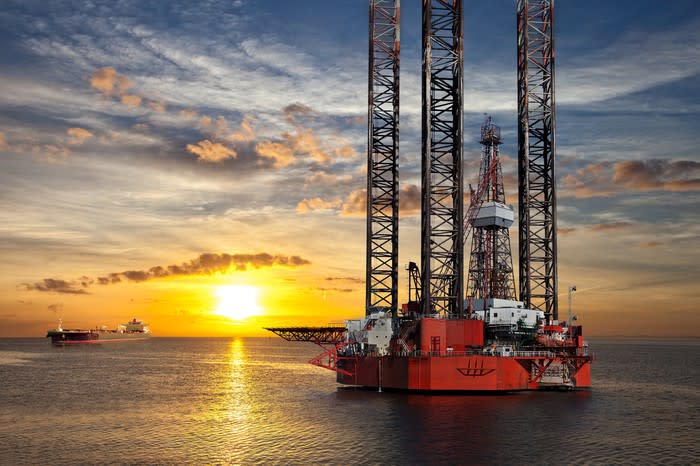Why the Offshore Drilling Recovery Is Real
After several years of declines, the offshore drilling market is on track to see its first annual increase in investment spending since crude oil prices started tanking in 2014. The industry's rebound should continue for several years, even though oil prices remain volatile. That was a clear takeaway from the comments of management teams across the sector during the second quarter. Here's why they believe that this recovery is for real.
We're trending in the right direction
Leading offshore drilling contractor Transocean (NYSE: RIG) was one of several companies seeing notable improvements in the market. CEO Jeremy Thigpen ran through some key trends on the company's recent second-quarter call:
[W]e're extremely pleased with the direction of the high specification harsh environment market where our top tier assets are fully utilized. Day rates are approaching and, in some cases, exceeding $400,000 per day. ... And while we're somewhat frustrated with the pace and trajectory of the ultra-deepwater market, we remind ourselves that we have moved off the bottom and are clearly in the early stages of what we expect will be a much broader recovery. ... We have spent the last several years positioning ourselves [for this recovery] by establishing the offshore drilling industry's largest and most profitable backlog, providing us with unparalleled visibility to future cash flows.
As Thigpen notes, the company has seen a definite improvement in two of the offshore drilling market's most important metrics: day rates and utilization. As those trends continue, the company and its peers will be able to make more money, since they'll have more rigs working at higher rates.

Image source: Getty Images.
We see an acceleration ahead
Olivier Le Peuch, the new CEO of leading oilfield service contractor Schlumberger (NYSE: SLB), also noted similar positives on that company's second-quarter call. First, he pointed out that shallow water rig activity improved by 14% during the second quarter. Meanwhile, he said that deepwater "is seeing less growth of rig activity at the moment, more single digit." Those trends should become even more pronounced in the coming quarters. That's because the industry is on track to make additional final investment decisions on deepwater projects during the third and fourth quarters. "That would translate in further growth and acceleration of deepwater as we expect into next year," according to Schlumberger's CEO.
We're in the early innings of a long game
Clay Williams, CEO of oilfield equipment maker National Oilwell Varco (NYSE: NOV) also sees several positives ahead for the offshore drilling market. An analyst on the company's second-quarter call stated that it seemed like the industry has recently hit an inflection point where orders are improving. That's driving the view that a sustainable multiyear recovery could be taking hold. Williams agreed with that sentiment, and stated:
I think it speaks to the long-term view that the operators have in the offshore. These are very long term projects and so our experience has been that the offshore operators are less reactive to kind of near-term commodity prices. They've taken their time over the last 4 or 5 years on working down costs and re-engineering these projects and getting comfort around the economic viability of these things because they're multiyear, sometimes multi-decade undertakings that they're embarking on. And given the rising level of inquiries and interest in the offshore that we hear from our drilling contractor customers, given the fact that the number of jackups for instance under contract picked up, I think, in Q2 over Q1, there are some signs out there that activity is starting to march upward and our belief is that the operators that are undertaking that activity will do so with conviction and commitment and follow through. So we're very hopeful that this is a market, just moving more slowly for instance in North America, but it's good to see it going up into the right somewhat.
As Williams' points out, oil companies have been deliberate in planning their offshore returns. They spent years driving down costs so that these investments would pay off at lower oil prices. While they're taking things slowly, industry activity levels are improving. That trend will continue since oil companies are approving an increasing number of these long-term projects.
Better days are up ahead
The offshore drilling market might not be improving as fast as the industry anticipated, but it is beginning to bounce back. That's evident in the fact that activity levels, day rates, and utilization were all on the rise during the second quarter. Those trends will likely continue since oil companies are methodically approving more long-term projects, which will boost demand for drilling rigs. This outlook suggests that offshore drilling stocks could bounce back over the next several years as this recovery continues.
Matthew DiLallo owns shares of National Oilwell Varco. The Motley Fool owns shares of National Oilwell Varco. The Motley Fool has a disclosure policy.
This article was originally published on Fool.com

 Yahoo Finance
Yahoo Finance 